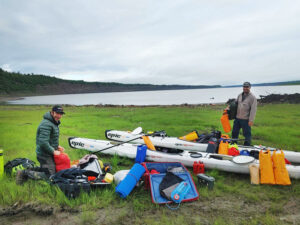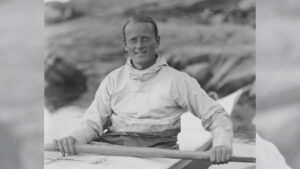The four kayakers who style themselves the Arctic Cowboys (even though only two of them are from Texas) made the biggest crossing of their expedition last week. They covered 100km across Prince Regent Inlet between Baffin and Somerset Islands and are now nearing the entrance to Bellot Strait, the kilometer-wide narrows leading into the Western Arctic. They should reach Fort Ross, an abandoned former trading post at the mouth of the strait, today.

Long-abandoned Fort Ross, at the mouth of Bellot Strait, still has one usable structure that serves as an occasional hunting cabin for Inuit traveling by snowmobile in spring. Photo: Jerry Kobalenko
In the two weeks since we last reported on them, the sea ice has melted/blown away nicely. The ice that kept them at their starting point for almost two weeks may be behind them. They also continue to make impressive mileage on the days that they do paddle. Forty kilometers is often a short day for them.


The satellite photo, top, indicates how little sea ice remains compared to two weeks ago, bottom photo. In the top photo, much of the white over the water is clouds, not ice.
Autumn begins in August
Their main obstacle now may be the prodigious 3,000km distance of the Northwest Passage. In just under five weeks, they’ve covered about 700km, perhaps the most difficult 700km of the journey.
But while the ice has receded, so has the brief arctic summer. By early August, the chill of autumn has entered the air. Birds are leaving. The midnight sun has already gone, although 24 hours of at least twilight remain for a few more days. Frost sometimes forms on the tent fly at night now. Every day, the sun’s zenith is lower in the sky.
Soon, travel becomes much less flexible because they can no longer rely on paddling whenever the water is calmest, whether noon or midnight. The number of hours of darkness per day will increase quickly at those latitudes.
They still have 2,300km to go. That is the main hurdle of the Northwest Passage: short summer, long distance. And while they have put in big spurts, they have also taken days off between them, in response to wind, ice, or fog. This has allowed them to rest after their marathon efforts.
They will still lose days to wind and waves, especially when unstable fall weather arrives. Whether they will be able to paddle well into October, marked by short days, subfreezing temperatures, and even rougher weather, may determine whether they make it all the way to Tuktoyaktuk. But so far, they’ve done better than the rowers and kayakers who tried before them.

The sea ice is almost behind them. Autumn ahead. Photo: Arctic Cowboys






